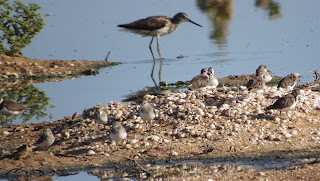I don't expect new birds in the Nouakchott area any more as I have birded it intensively for over 18 months. However, it does still happen.
It came in the form of a very scruffy Heuglin's wheatear.
Heuglin's wheatear 1
It's upright stance was reminiscent of an Isabelline wheatear but very little else was.
Heuglin's wheatear 2
It reminded me more closely to the red-breasted wheatear I used to see in south west Saudi Arabia but was more slender and slightly smaller.
Some characteristics that I picked up on included the white throat and orange breast.
Heuglin's wheatear 3
It has the Heuglin's characteristic brown back and the orange from breast extends low down as seen on the flanks in the above picture.
Heuglin's wheatear 4
The white supercilium is weak but present.
Heuglin's wheatear 5
The tail pattern is visible in the fifth picture and is consistent with this species.
Heuglin's wheatear 6
On returning home on Sunday, I immediately sent these pictures to Nik Berrow who is co-author of the book "Birds of Western Africa". He supports the identification.
distribution of Heuglin's wheatear (source: BirdLife International)
The distribution of the bird includes Nouakchott towards its north west edge. However, it is either quite rare in the far west of its range or I and others have been overlooking it.
Near-by at the waste site I found a good concentration of warblers. This is in a corner of the site with much less water than the main body but, crucially, bushes right up to the water and mud's edge.
spectacled warbler 1
Sardinian warbler has been the most common sylvia warbler all winter and yet in this session I failed to see a single one. Instead I got my first photos of a spectacled warbler in Mauritania.
spectacled warbler 2
A western sub-alpine warbler also obliged.
western sub-alpine warbler
Completing the types of sylvia warblers was a single female blackcap.
female blackcap
However, the most numerous warblers at this spot, once again were common chiffchaff and Iberian chiffchaff in roughly equal proportions.
A lone yellow wagtail was also found near-by whereas the rest of the site had only white wagtail.
yellow wagtail
A flock of Sudanese golden sparrow and a small number of house sparrow were also attracted to the same small corner of the site.
Sudanese golden sparrow
A young southern grey shrike was one of the noisiest birds around.
southern grey shrike
There have been two or three hoopoe on site all winter. I suspect they have been the same birds.
Hoopoe
Laughing dove is usually the main dove but in autumn for a couple of weeks it can be European turtle dove. In summer it can be speckled pigeon. This time the namaqua dove numbers rivalled those of laugihng dove.
Namaqua dove
The group of common teal have finally left the main body of water. The waders were nothing special though the ruff numbers are up and a small minority are turning into breeding plumage.
greenshank and little stint
The only greenshank is shown with several little stint in the main water body.
In all I saw 30 species which is up from the mid-winter lows and a sign of what is soon to come as spring approaches.


















No comments:
Post a Comment